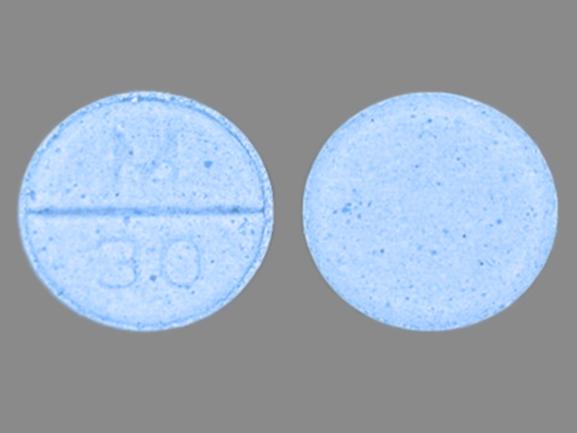Clorazepate Dosage
Medically reviewed by Drugs.com. Last updated on Jul 23, 2025.
Applies to the following strengths: 3.75 mg; 7.5 mg; 15 mg; 11.25 mg; 22.5 mg
Usual Adult Dose for:
Usual Pediatric Dose for:
Additional dosage information:
Usual Adult Dose for Anxiety
Initial dose: 15 mg orally at bedtime or in divided doses
Maintenance dose: 15 to 60 mg orally in divided doses
Comments:
- Drowsiness may develop at the start of treatment and with dosage increases.
- The usual daily dose is 30 mg/day.
- Efficacy of long-term management in patients with anxiety (e.g., greater than 4 months) has not been established.
Uses:
- Management of anxiety disorders
- Short-term relief of the symptoms of anxiety
Usual Adult Dose for Alcohol Withdrawal
Day 1: 30 mg orally, followed by 30 to 60 mg in divided doses
Day 2: 45 to 90 mg orally in divided doses
Day 3: 22.5 to 45 mg orally in divided doses
Day 4: 15 to 30 mg orally in divided doses
After Day 4: The daily dose should be reduced to 7.5 to 15 mg
Maximum dose: 90 mg/day
Comments:
- Use should be discontinued as soon as patient's condition is stable.
- Excessive reductions in the total amount of drug administered on successive days should be avoided.
Use: Symptomatic relief of acute alcohol withdrawal
Usual Adult Dose for Seizure Prophylaxis
Initial dose: 7.5 mg orally 3 times a day
Maintenance dose: May increase by no more than 7.5 mg orally every week
Maximum dose: 90 mg/day
Comments:
- To minimize drowsiness, the recommended initial dosages and dosage increments should not be exceeded.
- Continued therapeutic activity was established in patients with epilepsy during long-term studies.
Use: Adjunctive therapy in the management of partial seizures
Usual Pediatric Dose for Seizure Prophylaxis
9 to 12 years:
- Initial dose: 7.5 mg orally 2 times a day
- Maintenance dose: May increase by no more than 7.5 mg orally every week
- Maximum dose: 60 mg/day
12 years or older:
- Initial dose: 7.5 mg orally 3 times a day
- Maintenance dose: May increase by no more than 7.5 mg orally every week
- Maximum dose: 90 mg/day
Comments:
- To minimize drowsiness, the recommended initial dosages and dosage increments should not be exceeded.
- Continued therapeutic activity was established in patients with epilepsy during long-term studies.
Use: Adjunctive therapy in the management of partial seizures
Renal Dose Adjustments
Renal dysfunction: Frequent monitoring recommended.
Liver Dose Adjustments
Liver dysfunction: Frequent monitoring recommended.
Dose Adjustments
Elderly and/or debilitated patients:
- Initial doses should be decreased, and titration should be determined by the patient's response to treatment.
- Anxiety: Treatment should be initiated at a daily dose of 7.5 to 15 mg.
Precautions
US BOXED WARNINGS:
RISKS FROM CONCOMITANT USE WITH OPIOIDS:
- Concomitant use of benzodiazepines and opioids may result in profound sedation, respiratory depression, coma, and death.
- Reserve concomitant prescribing of these drugs for use in patients for whom alternative treatment options are inadequate.
- Limit dosages and durations to the minimum required.
- Follow patients for signs and symptoms of respiratory depression and sedation.
Safety and efficacy have not been established in patients younger than 9 years; this drug is not recommended for use in these patients.
Consult WARNINGS section for additional precautions.
US Controlled Substance: Schedule IV
Dialysis
Data not available
Other Comments
Storage requirements:
- Protect from light and moisture.
General:
- Anxiety/tension associated with the stress of everyday life usually does not require treatment with an anxiolytic.
- Patients should be periodically reassessed for the continued need of treatment.
Monitoring:
- Hematologic: Periodic blood counts
- Hepatic: Periodic liver function tests
- Patients with a history of alcohol or drug abuse should be monitored frequently.
- Patients should be monitored for worsening and emergence of suicidal thoughts.
Patient advice:
- Patients should be cautioned accordingly since this drug may impair the mental and/or physical abilities required for the performance of operating an automobile or machinery.
- Patients and caregivers of those who are taking concomitant opioid therapy should be told to immediately report profound central nervous system or respiratory depression.
- Patients should be told to avoid drinking alcohol or taking other drugs that may cause sleepiness or dizziness while taking this drug until you talk to your healthcare provider.
- If this drug is prescribed to a woman of childbearing potential, she should be warned to contact her physician regarding discontinuation if she intends to become pregnant or is pregnant.
More about clorazepate
- Check interactions
- Compare alternatives
- Pricing & coupons
- Reviews (56)
- Drug images
- Side effects
- During pregnancy
- Drug class: benzodiazepines
- Breastfeeding
- En español
Patient resources
Other brands
Tranxene, Tranxene T-Tab, Tranxene SD
Professional resources
Other brands
Related treatment guides
See also:
Further information
Always consult your healthcare provider to ensure the information displayed on this page applies to your personal circumstances.


